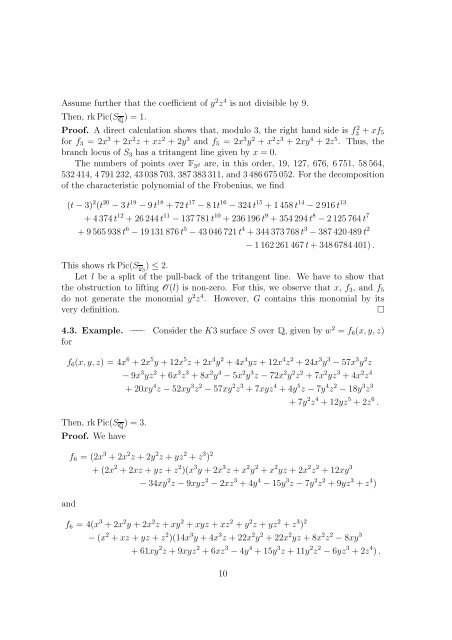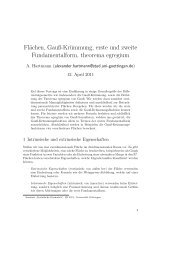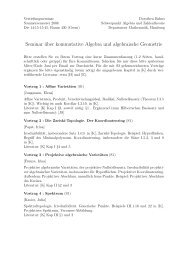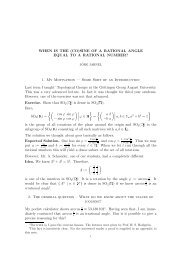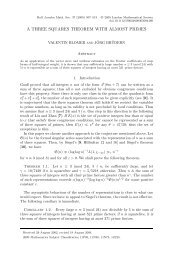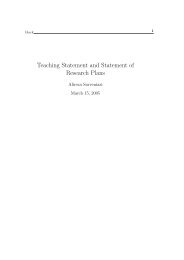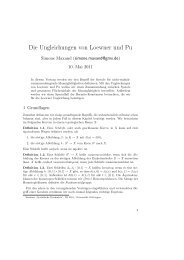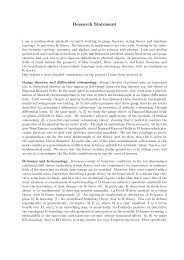The Picard group of a K3 surface and its reduction modulo p
The Picard group of a K3 surface and its reduction modulo p
The Picard group of a K3 surface and its reduction modulo p
You also want an ePaper? Increase the reach of your titles
YUMPU automatically turns print PDFs into web optimized ePapers that Google loves.
Assume further that the coefficient <strong>of</strong> y 2 z 4 is not divisible by 9.<br />
<strong>The</strong>n, rk Pic(SÉ) = 1.<br />
Pro<strong>of</strong>. A direct calculation shows that, <strong>modulo</strong> 3, the right h<strong>and</strong> side is f3 2 + xf 5<br />
for f 3 = 2x 3 + 2x 2 z + xz 2 + 2y 3 <strong>and</strong> f 5 = 2x 3 y 2 + x 2 z 3 + 2xy 4 + 2z 5 . Thus, the<br />
branch locus <strong>of</strong> S 3 has a tritangent line given by x = 0.<br />
<strong>The</strong> numbers <strong>of</strong> points over3 d are, in this order, 19, 127, 676, 6 751, 58 564,<br />
532 414, 4 791 232, 43 038 703, 387 383 311, <strong>and</strong> 3 486 675 052. For the decomposition<br />
<strong>of</strong> the characteristic polynomial <strong>of</strong> the Frobenius, we find<br />
(t − 3) 2 (t 20 − 3 t 19 − 9 t 18 + 72 t 17 − 8 1t 16 − 324 t 15 + 1 458 t 14 − 2 916 t 13<br />
+ 4 374 t 12 + 26 244 t 11 − 137 781 t 10 + 236 196 t 9 + 354 294 t 8 − 2 125 764 t 7<br />
+ 9 565 938 t 6 − 19 131 876 t 5 − 43 046 721 t 4 + 344 373 768 t 3 − 387 420 489 t 2<br />
− 1 162 261 467 t + 348 6784 401).<br />
This shows rk Pic(S3 ) ≤ 2.<br />
Let l be a split <strong>of</strong> the pull-back <strong>of</strong> the tritangent line. We have to show that<br />
the obstruction to lifting O(l) is non-zero. For this, we observe that x, f 3 , <strong>and</strong> f 5<br />
do not generate the monomial y 2 z 4 . However, G contains this monomial by <strong>its</strong><br />
very definition.<br />
□<br />
4.3. Example. –––– Consider the <strong>K3</strong> <strong>surface</strong> S overÉ, given by w 2 = f 6 (x, y, z)<br />
for<br />
f 6 (x, y, z) = 4x 6 + 2x 5 y + 12x 5 z + 2x 4 y 2 + 4x 4 yz + 12x 4 z 2 + 24x 3 y 3 − 57x 3 y 2 z<br />
<strong>The</strong>n, rk Pic(SÉ) = 3.<br />
Pro<strong>of</strong>. We have<br />
<strong>and</strong><br />
− 9x 3 yz 2 + 6x 3 z 3 + 8x 2 y 4 − 5x 2 y 3 z − 72x 2 y 2 z 2 + 7x 2 yz 3 + 4x 2 z 4<br />
+ 20xy 4 z − 52xy 3 z 2 − 57xy 2 z 3 + 7xyz 4 + 4y 5 z − 7y 4 z 2 − 18y 3 z 3<br />
f 6 = (2x 3 + 2x 2 z + 2y 2 z + yz 2 + z 3 ) 2<br />
+ 7y 2 z 4 + 12yz 5 + 2z 6 .<br />
+ (2x 2 + 2xz + yz + z 2 )(x 3 y + 2x 3 z + x 2 y 2 + x 2 yz + 2x 2 z 2 + 12xy 3<br />
− 34xy 2 z − 9xyz 2 − 2xz 3 + 4y 4 − 15y 3 z − 7y 2 z 2 + 9yz 3 + z 4 )<br />
f 6 = 4(x 3 + 2x 2 y + 2x 2 z + xy 2 + xyz + xz 2 + y 2 z + yz 2 + z 3 ) 2<br />
− (x 2 + xz + yz + z 2 )(14x 3 y + 4x 3 z + 22x 2 y 2 + 22x 2 yz + 8x 2 z 2 − 8xy 3<br />
+ 61xy 2 z + 9xyz 2 + 6xz 3 − 4y 4 + 15y 3 z + 11y 2 z 2 − 6yz 3 + 2z 4 ) .<br />
10


